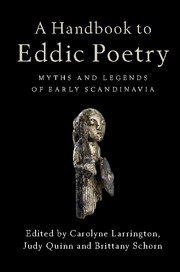Book contents
- Frontmatter
- Contents
- List of illustrations
- List of contributors
- Translations and abbreviations of the titles of eddic poems
- Introduction
- 1 The transmission and preservation of eddic poetry
- 2 Traditions of eddic scholarship
- 3 The editing of eddic poetry
- 4 The dating of eddic poetry
- 5 Eddic performance and eddic audiences
- 6 Eddic poetry and mythology
- 7 Eddic poetry and the religion of pre-Christian Scandinavia
- 8 Eddic poetry and heroic legend
- 9 Place names in eddic poetry
- 10 Eddic poetry and the imagery of stone monuments
- 11 Eddic poetry and archaeology
- 12 Eddic modes and genres
- 13 Eddic metres
- 14 Eddic style
- 15 Kennings and other forms of figurative language in eddic poetry
- 16 Alliterative lexical collocations in eddic poetry
- 17 The representation of gender in eddic poetry
- 18 The reception of eddic poetry
- Consolidated bibliography
- Index
8 - Eddic poetry and heroic legend
Published online by Cambridge University Press: 05 August 2016
- Frontmatter
- Contents
- List of illustrations
- List of contributors
- Translations and abbreviations of the titles of eddic poems
- Introduction
- 1 The transmission and preservation of eddic poetry
- 2 Traditions of eddic scholarship
- 3 The editing of eddic poetry
- 4 The dating of eddic poetry
- 5 Eddic performance and eddic audiences
- 6 Eddic poetry and mythology
- 7 Eddic poetry and the religion of pre-Christian Scandinavia
- 8 Eddic poetry and heroic legend
- 9 Place names in eddic poetry
- 10 Eddic poetry and the imagery of stone monuments
- 11 Eddic poetry and archaeology
- 12 Eddic modes and genres
- 13 Eddic metres
- 14 Eddic style
- 15 Kennings and other forms of figurative language in eddic poetry
- 16 Alliterative lexical collocations in eddic poetry
- 17 The representation of gender in eddic poetry
- 18 The reception of eddic poetry
- Consolidated bibliography
- Index
Summary
Introduction
In his preface to a recent collection of essays on eddic heroic poetry and heroic legend, Tom Shippey remarks on the nineteenth-century realisation that ‘there was something recognisable in the heroic poems of what came to be called “the Elder Edda”’ (Shippey 2013: xiv). The compendium's heroes – Sigurðr, Atli, Jǫrmunrekkr, Þjóðrekr, even Brynhildr – were identifiable from historical sources such as Ammianus Marcellinus, Jordanes, and Gregory of Tours, and, in some cases, from their appearances in Old English or Old High German poetry – poems which predated the manuscripts in which the Old Norse verse was preserved by hundreds of years (see Shippey 2013, 1982; C. Tolkien 1953–57). The names – also sometimes the place names – remained the same, but the details of their stories, from dragon-slaying to unwitting cannibalism, from being rendered limbless to falling foul of Óðinn, were very different. A good number of eddic heroic poems, primarily the verse preserved in the Codex Regius, relate to a pan-Germanic legendary; they recall the Migration Age heroes whose names and deeds survived almost a millennium in the oral tales of the Anglo-Saxons, the Germans, and the Scandinavians. Tales of Vǫlundr the smith, of Hildibrandr, and the probably ancient sequence of verses sometimes known as Hlǫðskviða (Poem of Hlǫðr) or The Battle of the Goths and Huns also belong in this category. The poems associated with these legends span a remarkable range of genres, for, as Shippey notes, though eddic ‘heroes may choose not to speak … heroines have different speech privileges’ (2013: xviii). Thus, heroic narrative expands to encompass both male and female perspectives and heroic behaviour is both celebrated and critiqued in the poems preserved in the second half of the Codex Regius (see Clark 2012: 17–45; 67–88).
These ancient Germanic figures were not, of course, the only heroes commemorated in eddic poetry; by heroes, I mean humans who take up arms against human or supernatural foes, who are brave and fearless, but not necessarily morally admirable. The fornaldarsǫgur preserve poems about certain exclusively Scandinavian figures: Starkaðr, Angantýr, Hjálmarr, and Ǫrvar-Oddr (see Clunies Ross 2013).
- Type
- Chapter
- Information
- A Handbook to Eddic PoetryMyths and Legends of Early Scandinavia, pp. 147 - 172Publisher: Cambridge University PressPrint publication year: 2016
- 5
- Cited by

